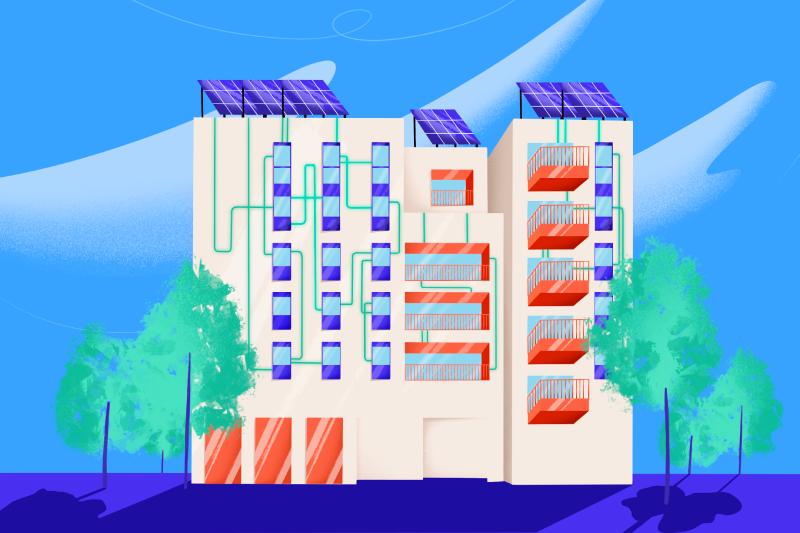Discovering the many benefits of RCPs

Thanks to RCPs (Swiss collective system of energy self-consumption), investing in photovoltaics is good for your wallet and good for the planet!
Since the new Energy Act came into force in 2018, tenants and condominium owners can now consume solar-generated electricity on the roof of their building. This is known as a RCP (Regroupement pour la Consommation Propre or Swiss collective system of energy self-consumption), and the owner or PPE (building with divided ownership) thus becomes the building's electricity supplier instead of the local distributor.
"We wanted to do our bit for the energy transition"
A pioneer in this field, the Coopérative de Charmontey in Vevey has equipped its 11 buildings using this model to supply solar electricity to its 230 or so flats. "We wanted to do our bit for the energy transition," explains Pierre-André Debétaz, head of buildings at the cooperative.
So, if you own a flat block or a commercial property, have you thought about investing in a photovoltaic system and setting up an RCP?
What's an RCP?
Own consumption is the local consumption of electricity generated by photovoltaic panels installed on the roof or facade of a building. Occupants of rental properties and condominiums form an RCP to consume the solar-generated electricity produced on their building. The owner or the PPE invests in the installation, then sells the solar-generated electricity to the members of the RCP for self-consumption.
Note: the distribution network operator (DNO) supplies the building with electricity when solar production is insufficient, and buys back the surplus if production is excessive.
What are the advantages of an RCP?
Whether you look at the financial, environmental or property value aspects, to name but the main ones, RCPs have many advantages.
Financial benefits
So first of all, there are the financial advantages, because we're talking about an investment here :
- Faster amortisation of the photovoltaic installation for the investor who owns the system: he will sell his electricity at a higher price to direct consumers than to the grid
- Buy-back by the DNO of electricity not consumed: even if it is not sold at the same price as to RCP residents, it is a financial added value
- Federal subsidies for installation (around 20-25% of total investment)
- Yield of 7 to 10% over 25 years
For instance, 30,000 kWh produced annually and invoiced at between 20 and 25 cents per kWh generate between CHF 6,000 and 7,500 per year for the PPE, thanks to an investment of CHF 50 to 60,000 in a 150 m² panel installation.
Environmental benefits
Secondly, this investment reflects the values shared by a growing proportion of the population in the fight against global warming and environmental protection in general:
- Helping to fight climate change by producing renewable energy.
- Local production: less environmental and economic impact because transport is eliminated. On average, photovoltaic installations cover 30% of the electricity needs of the buildings they supply. That's a lot of autonomy!
- Raising residents' awareness of their electricity consumption and how to optimise it: they can view their consumption on their smartphone and adapt their consumption to reduce their ecological impact (and their expenses). For example, they can see the energy consumption of certain items of equipment when they are put on standby, or of an old appliance that is particularly power-hungry, and decide to unplug it at night or change it, respectively.
Benefits associated with increasing the value of the property for occupants
Benefits associated with increasing the value of the property for residents:
- Immediate and lasting reduction in the electricity bill of local residents, as the solar-generated electricity is sold to them at a lower rate than that charged by the local electricity distributor.
- Consumption of local renewable energy.
- Greater independence from the electricity grid, and therefore cushioning any rise in consumer rates. As we saw earlier, on average, buildings equipped with a photovoltaic system achieve 30% autonomy.
- If the RCP consumes more than 100,000 kWh per year, it can access the free energy market and break all ties with its DNO to benefit, in certain cases, from much more advantageous rates.
- And last but not least, there's the added social benefit that such an installation leads to positive discussions between tenants and/or owners, which in turn creates cohesion at the heart of the community (PPE, condominiums, blocks of rental flats, etc.).
Focus on self-consumption: a win-win bet
Since there are no taxes or grid charges for self-consumed electricity, solar power generated on your own roof is more cost-effective than electricity purchased from the grid. The more solar-generated electricity the building consumes on site, the more profitable the photovoltaic system is, and the lower the electricity bills for the residents. It's a win-win situation for owners and tenants alike!
About Climkit
Climkit has been promoting the production of photovoltaic electricity since the launch of its solution in 2017 for managing the self-consumption groups in Vevey (VD).
Since then, we have extended our offer to all forms of energy and consumption in a building: heat, cold, water, laundry, electric mobility, etc. We facilitate the management of your building thanks to our counting, billing, visualization and optimization tools. Active throughout Switzerland, we work with local professional companies for the design and installation of our products. We're also proud that our Community solution has been approved by the Solar Impulse Foundation.
Our entire team is available to assist you in your projects, as we support the 1500 RCPs who place their trust in us!
